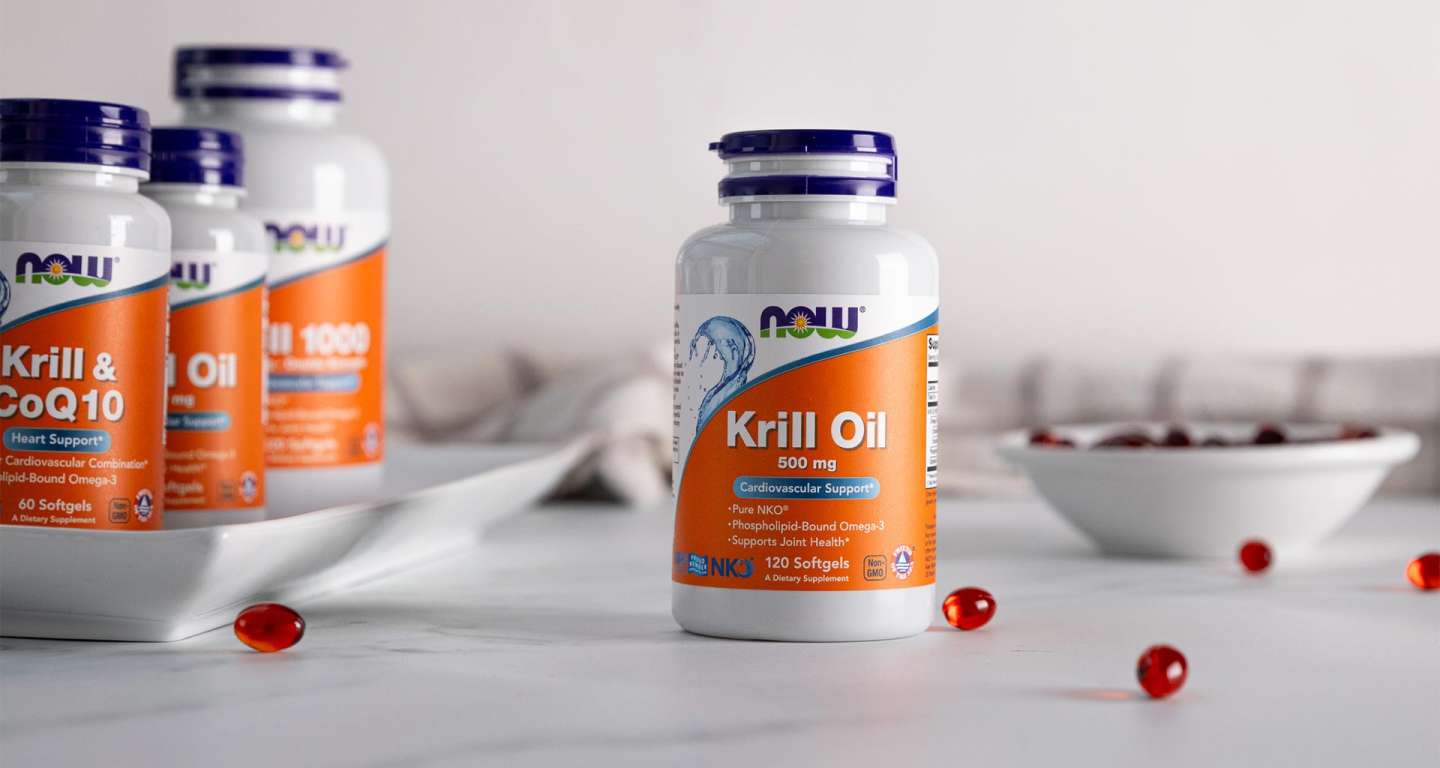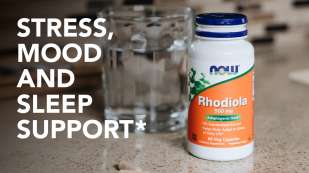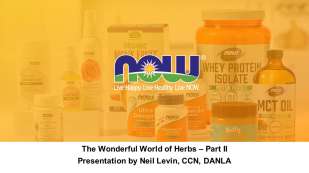Use coupon code CARDAMOM with your purchase of $40 or more for a free†
Cardamom OilKrill Oil's Unique Properties

Krill Oil (NKO®) is known as being a fish oil alternative that similarly supplies the biologically essential omega-3 fatty acids known as EPA and DHA. However, unlike ordinary fish oil, fatty acids from krill are in a natural food complex that includes phospholipids and astaxanthin, which give NKO® krill oil some unique and interesting biological properties. NOW uses Neptune Krill Oil (NKO®), a clinically validated, high-quality krill oil.
See Krill Oil FAQs for basic information about the type of crustacean (Euphausia superba) that NKO® is derived from and how it is sustainably harvested.
In this article, we’ll review some other qualities of NKO® based on its special mixture of nutritional components.
EPA and DHA Omega-3 Fatty Acids
DHA and EPA are the two most active polyunsaturated fatty acids in the human body, contributing to all health benefits associated with omega-3 fatty acids. The health benefits of these nutrients are very well documented, so we won’t repeat that information here.
Krill oil, like fish oil, is a natural source of these essential fatty acids (EFAs). However, in krill oil these fatty acids are bound to phospholipids, enhancing their bioavailability. Unlike the common triglyceride form of omega-3 fatty acids in fish oil, the phospholipid form found in krill oil can easily mix with water (unlike other oils) and be absorbed into the body without the usual need for bile salts, which enhances ease of digestion and bioavailability.
In 1,000 mg (one gram) of NKO® the typical omega-3 fatty acid level is 230 to 300 mg. For the main two essential omega-3 fatty acids, the typical eicosapentaenoic acid (EPA) content is 140 to 160 mg and for docosahexaenoic acid (DHA) content it is 80 to 90 mg.
Like fish oils, NKO® naturally has smaller amounts of other fatty acids. Its typical omega-6 fatty acid content is 10 to 20 mg per gram; and its omega-9 fatty acid content is typically 60 to 80 mg per gram.
Phospholipids
Phospholipids have received justifiable scientific interest because of their ability to support healthy body structures and functions.* Phospholipids are a group of phosphorus-containing fats that are found in virtually every cell of the body.
Phospholipids are a class of fat-like molecules that promote cell membrane fluidity, facilitate cell-to-cell signaling, and assist in the processing of nutrients by the cell.* Membranes are the fatty barriers that surround every cell, and many structures within the cell. As we age, our cell membranes tend to get more rigid, and this makes them more resistant to the movement of molecules within the membrane, as well as to the transfer of molecules into and out of the cell. This decrease in molecular movement can result in reduced communication between cells, ultimately reducing healthy cellular function.
Lecithin is the most common dietary source of phospholipids (which are found in many animal tissues and organs as an important constituent of biological membranes). Lecithin is also widespread in the plant world and abundant in legumes, cereals, and seed embryos, as well as in egg yolks and some vegetable oils. Phospholipids also play a role in memory and cognitive function, nerve health, cardiovascular health, and liver function.*
While the best known phospholipid source is lecithin, commonly found in egg yolks and commercially distilled from highly purified soybean oil, more recent products like sunflower lecithin and krill oil are getting recognition as alternative sources.
Natural sources of phospholipids typically provide a complex mixture of phosphatides that consist primarily of phosphatidylcholine (phosphatidyl choline, or PC), plus smaller amounts of phosphatidylethanolamine (phosphatidyl ethanolamine, or PE), phosphatidylinositol (phosphatidyl inositol, or PI), and minor amounts of other components including phosphatidylserine (phosphatidyl serine, or PS).
NKO® is a soy-free, egg-free source of phospholipids. About 40% of NKO® by weight consists of phospholipids (typically 390-420 mg/g). Phospholipids from animal sources have a higher percentage of longer-chain fatty acids with a higher degree of unsaturation than plant-source phospholipids. This, combined with the high levels of EPA and DHA essential omega-3 fatty acids in krill oil, make it more closely resemble human brain phospholipids. In fact, one study showed that phospholipid-bound fatty acids were absorbed twice as well by the infant brain of primates as the triglyceride form. http://www.ncbi.nlm.nih.gov/pubmed/11861929
Phosphatidylcholine
Phosphatidylcholine (phosphatidyl choline, or PC) typically represents about 80% of the phospholipid content of NKO®. Phosphatidylcholine is one of the primary membrane phospholipids, which help form the outer layer of cellular and other biological membranes and is the layer that is exposed to water and water-soluble substances.*
Phosphatidylcholine is also the principal phospholipid circulating in plasma, where it is an integral component of the lipoproteins, especially HDL (the so-called “good cholesterol”).* Research has shown that PC can support a normal mood, cognitive function (including memory), and neurological health.*
Phosphatidylethanolamine
Phosphatidylethanolamine (phosphatidyl ethanolamine or PE) is the next most abundant phospholipid in NKO® and is typically present at levels of 2 to 5% of NKO’s phospholipid total, by weight. PE is frequently the main lipid component of microbial membranes and can amount to 20% of liver phospholipids, and up to 45% of brain phospholipids.* Higher proportions are found in the mitochondria than in other cellular organelles.*
PE is a key building block of membrane bilayers, where phospholipids are stacked two molecules thick with the water-soluble ends facing away from the middle and toward both the inside and outside of the cell. This facilitates contact with the mostly watery environment on each side of the membrane and makes the bilayered membrane in animal or human cells a virtual “sandwich” with molecules of cholesterol floating around among the phospholipids, adding rigidity. The lipid bilayer also acts as a barrier to substances entering or leaving the cell without help from other molecules coating the membrane surface, such as carbohydrates and proteins, which serve as receptor sites for messenger molecules. Receptors facilitate interaction with the cell membrane, allowing molecular cell-to-cell communication signals to pass from the outside to the inside of the cell. The water-soluble phospholipid ends on both surfaces of the cell membrane allow only partial penetration of water-borne substances through that cell membrane because the water resistant phospholipid ends and the inner layer form a barrier unless specific receptors aid that passage.
Phosphatidylinositol
Phosphatidylinositol (phosphatidyl inositol, or PI) is another phospholipid in NKO® and is typically present at levels of 1 to 3% of NKO’s phospholipid total, by weight. Phosphatidylinositol is especially abundant in brain tissue, where it can amount to 10% of the phospholipids, but it is present in all tissues and cell types.
Phosphatidylserine
Phosphatidylserine (phosphatidyl serine or PS) is another naturally occurring phospholipid in NKO® and is typically present at levels of 1 to 2% of NKO’s phospholipid total, by weight. PS is critical for the normal functioning of all cells and is the phospholipid most concentrated in the brain and nervous system, where it is important for the conduction of nerve impulses.* PS is essential for the accumulation, storage, and release of neurotransmitters; thus supporting brain and cognitive functions, including mood and memory.* The greatest concentration in humans is in myelin found in brain tissue, and it is also relatively abundant in the plasma membrane of cells and in cells’ endoplasmic reticulum (cellular organelles that serve as facilities for protein synthesis and storage, steroid synthesis and storage, and ion storage).
Sphingomyelin
Sphingomyelin is another naturally occurring phospholipid in NKO® and is typically present at levels of 1 to 2% of NKO’s phospholipid total, by weight. Only found in animals and humans, it is the sphingolipid analogue of phosphatidylcholine, and contains phosphorylcholine in a complex molecular structure.
Sphingolipids are named that because of their once-enigmatic nature. In sphingolipids, fatty acids are linked via amide bonds to a long-chain base (sphingoid). Sphingomyelin is in all animal cell membranes, where it is by far the most abundant sphingolipid. While it can comprise up to 50% of the lipids in some tissues, it is usually lower in concentration than phosphatidylcholine. Sphingomyelin makes up about 10% of the lipids in the brain. It is the single most abundant lipid in the red blood cells (erythrocytes) of most ruminant animals, where it actually replaces phosphatidylcholine. As with phosphatidylcholine, sphingomyelin usually is in greatest concentration in the plasma membrane of cells. In the membrane of the human eye lens, sphingomyelin can comprise over 50% of the total phospholipid content. There is a lot of variability in the fatty acid content of sphingomyelin. About 60% of the fatty acids found in the sphingomyelin of human brain grey matter consist of stearic acid (18:0), proving that this sometimes-maligned fatty acid, present in virtually every natural plant and animal fat, is essential to human life in general, and our brain structures and functions in particular.* Sphingomyelin is also present in testes and sperm; in this case comprised of very long-chain fatty acids.
One important function of sphingomyelin is to serve as a chemically distinct substitute for phosphatidylcholine in forming a building block of membranes.* It does this by forming a stable, chemically resistant outer “leaflet” of the plasma membrane’s lipid bilayer.* Sphingomyelin and cholesterol metabolism are closely integrated, and it’s been suggested that sphingomyelin may control the distribution of cholesterol in cells since these two substances are most abundant in the same types of membranes.* Sphingomyelin has a role in supporting intracellular messengers and cell membrane components.* It also has been shown to play a role in maintaining a healthy HDL/LDL cholesterol ratio.*
Astaxanthin
Astaxanthin is a naturally occurring carotenoid that, because of its unique structure, provides a wide range of free radical-scavenging benefits.* Astaxanthin can help to protect cell membranes against free radical attack and potentiates the action of antioxidants such as Vitamins E and Vitamin C.* Scientific studies have demonstrated that astaxanthin can help to support immune function and neurological health.*
Astaxanthin belongs to the same family of fat-soluble carotenoid molecules as yellow/orange-colored beta-carotene. It differs from beta-carotene in that its molecular structure contains two additional oxygen groups in each ring structure. This gives it a deep red color and classifies it as a xanthophyll, with up to 10 times stronger free radical-scavenging activity.* Another difference is that, unlike beta-carotene, astaxanthin cannot be converted to vitamin A in the human body.
*These statements have not been evaluated by the Food and Drug Administration. These products are not intended to diagnose, treat, cure or prevent any disease.











